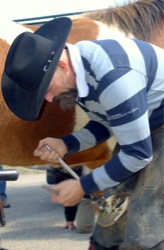Chris Gregory certainly knows how to pack ’em in.
About 120 farriers from around the country packed Centaur Forge in Burlington, Wis., on Saturday for the Delta Mustad Hoofcare Center clinician’s presentation on
.
Gregory’s reputation definitely precedes him, as the turnout attests.
“We had about 120 sign up,” says Bekki Bass of Centaur Forge. “Normally, we have 75. Some farriers just know that we always have this clinic, but I would attribute it mostly to Chris. I know he’s why people want to be here.”
The techniques Gregory has developed came about out of necessity.
“I live in a world in Missouri where if a vet’s called out, it’s usually the end of the road,” says the owner of the Heartland Horseshoeing School in Lamar, Mo. “We don’t live around very many horse vets. So, most of the time whenever I’m doing this sort of stuff, I’m on my own.”
Yet, this also has enabled Gregory to hone his craft and cultivate techniques that have proven successful.
“On the one hand, it’s good because I get to do some cool stuff out of my own head,” he says. “On the down side, I don’t have the diagnostic stuff. So, a lot of times I’m kind of flying blind. The bright side of that is after 20 years of being in this area, I developed some things that work pretty well for me. So, even without the vet’s intervention, we’ve been able to do real well on some foundered horses just by using some solid principles and solid basics.”
Those principles and basics begin with the forge and anvil.
“I’m very traditional,” says the International Horseshoeing Hall Of Famer. “I don’t have a grinder or a welder in my rig. Everything is pretty much off the anvil and hammer.”
Learning how and why to make and apply a specific shoe not only will benefit a laminitic horse, it will bolster a farrier’s practice.
“When you learn how to forge bar shoes, and you charge your customers like you bought them, throughout your career you’ll make thousands of dollars more,” Gregory explains. “People will be paying you for the practice because you’re charging for the bar shoes.”
Another vital basic in shoeing any horse is anatomical knowledge.
“Every day, there are horses that are shod incorrectly because there is a really flashy article, a really clever salesman, a really nice packaged material and the people applying them don’t understand anatomical principles,” he says. “Horses are incredibly forgiving, but there is not one size or one angle for every horse.”
The farriers who attended say they came away with some great suggestions that they can apply in their own practice.
“I thought Chris gave good advice for every day shoeing, and some good tips for the guys who want to get their certification,” says Shreve, Ohio, farrier Lester Yoder. “He also covered how to think outside the box in order to do what’s best for the horse. Every day shoeing is what pays the bills for me. So, I would say that was the most important part to me.”
For Gregory’s part, he’s just grateful for the opportunity to help his fellow farriers.
“I hope it inspires them to go out and learn more,” he says. “I know how important Saturdays are. For me, I never get one. So, it means a lot for farriers to spend a Saturday with me.”
Find a horseshoeing clinic in your part of the country by visiting the American Farriers Journal’s Events Page.








Post a comment
Report Abusive Comment